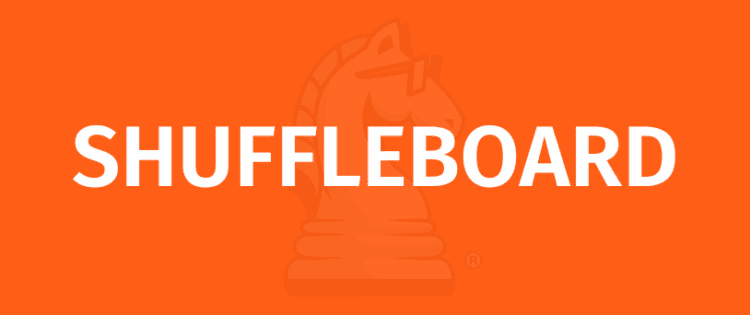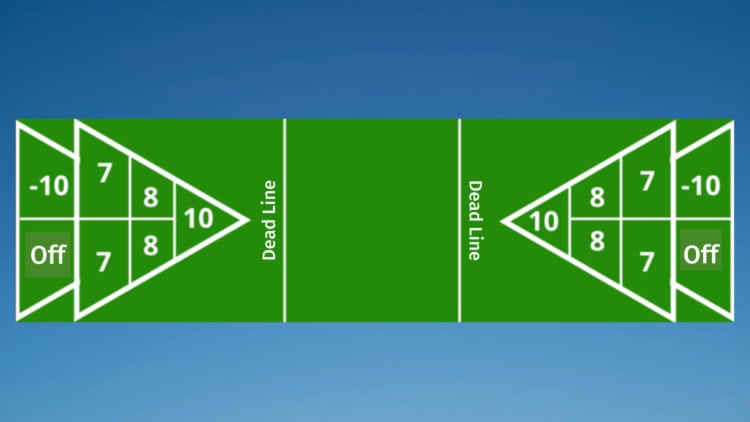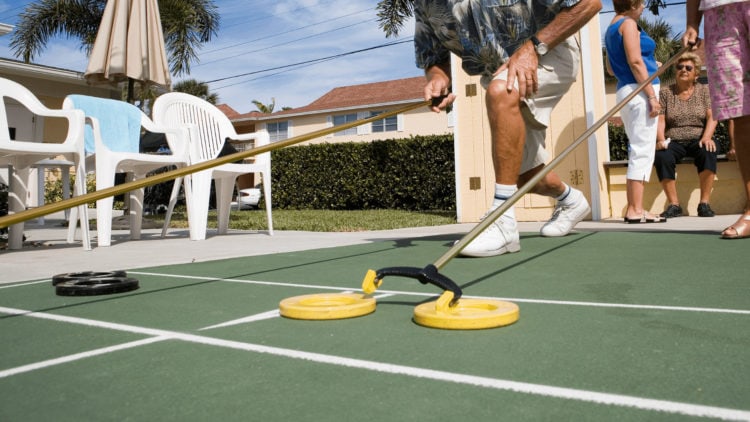
OBJECTIVE OF SHUFFLEBOARD: Win points by getting the disk to stop in the scoring zone.
NUMBER OF PLAYERS: 2 or 4 players, 1 or 2 on each team
MATERIALS: 1 cue per player, 2 sets of 4 disks
TYPE OF GAME: Sport
AUDIENCE: All ages
OVERVIEW OF SHUFFLEBOARD
Shuffleboard is a sport that even the least athletic of us can play! Shuffleboard was first created in pubs and parlors in Great Britian. It was initially called “shove a penny,” it was first played and popularized in the 1500s.
Although the concept is simple, the game is much more challenging to play than you would think! But the basic idea is to slide the disk down to the scoring zone to gain points. In this article, we will review the Shuffleboard rules for indoor and outdoor games.
Another great sport that is easy to learn but hard to master is Table Tennis. If you are looking for a sport that has similarities to Shuffleboard, try Curling.
SETUP FOR SHUFFLEBOARD

A shuffleboard court is a rectangular court that is 6 feet wide and 52 feet long. Each side of the court mirrors the other.
The player shooting area is a six and a half feet area at each end of the court. A baseline marks the area. Above the baseline on each end is the 10-off area separated into left and right sides. The 10-off area has a slant at the same angle as the isosceles triangle above it.
The isosceles triangle above the 10-off area is the scoring zone. This triangle is 6 feet by 9 feet and is divided into five zones: 1 zone at the top and four zones below it, separated by a vertical and horizontal line. The tip of the triangle is 10 points, the two underneath it are worth 8, and the bottom two are worth 7 points each.
Three feet from the very tip of the triangle, another line marks the deadline, leaving 12 feet in the middle. Any disk that lands between the two deadlines is out of play.
Place the yellow disks side-by-side on the right side of the 10-off area and put the black disks on the left side.
EQUIPMENT
You will need for outdoor Shuffleboard, also known as Deck Shuffleboard, two different colored sets of 4 weighted disks each. Each player will also need a cue, a long pole to push your disks down the court.
For indoor Shuffleboard, often called Table Shuffleboard, you will also need two different colored sets of 4 weighted disks, but the ones used for Table Shuffleboard are smaller. You will also push your disks with your hands, so there is no need for a cue. You will need, however, a Shuffleboard table to play on.
HOW TO PLAY SHUFFLEBOARD

You and your opponent will stand near the disks on one end of the court.
Flip a coin or play rock, paper, scissors to decide who will play yellow and who will play back. The winner can decide on the color they want to play. Yellow goes first.
To play Shuffleboard, you will use your cue to push your disk down the court to the other side to get a point. The players take turns (yellow, black, and yellow again) until you have pushed all of your four disks.
Each disk must start within the 10-off area. Then, you will aim to send your disks past the deadlines, down to the scoring triangle on the opposite end of the court.
You should attempt to do one of the following with your cue and disk:
- Put the disk into the scoring area;
- Displace an opponent’s disk; or
- Both
IN DOUBLES
In doubles shuffleboard, you and your teammate split the four disks of your color. You and your teammate will shoot alternately.
HOW TO SCORE IN SHUFFLEBOARD
The five different areas in the scoring zone determine the five different points you can get. At the top are 10 points, followed by two 8 points, and finally two 7-point areas. You must use your cue to slide your disks down to the scoring zone to get points.
For you to get points, the disk must entirely lie within the boundaries of the score. In other words, the disk must not touch any lines. For example, if you manage to slide a disk down to the 10-point zone, but the disk touches the boundary of the triangle, then no points are awarded.
PENALTIES
Shuffleboard is more complex than sliding down a disk across the length of the court. If you do not play correctly, you risk having to remove your offending disk. You will also receive a penalty of a certain amount of points.
- You will lose 5 points if, before you play, a disk touches the lines surrounding the 10-off.
- You will lose 10 points if, before you play, a disk touches the sidelines or the triangle lines.
- Ten points are lost if any part of your body goes beyond or touches the baseline when shooting a disk.
- Ten points are lost if you shoot an opponent’s disk.
The opponent will replay the disk if you move any of the opponent’s disks due to an illegal shot.
TABLE (INDOOR) SHUFFLEBOARD RULES
Table Shuffleboard, also known as indoor Shuffleboard, varies slightly from its Deck Shuffleboard counterpart.
PLAY AREA SIZE
The most significant change in indoor Shuffleboard is in court size. While deck Shuffleboard has a 52-foot-long court, table Shuffleboard rules only use a table. At its full regulation length, the Shuffleboard table is 22 feet long. The goal of the game remains the same for each, however.
GAMEPLAY
Indoor Shuffleboard rules use your hands to propel your disks down the table. This action uses less upper body strength than trying to use a cue. For this reason, this version of the game is more suitable for the elderly and small kids.
SCORING
Scoring is also vastly different between these two versions. We have discussed the layout and scoring for deck Shuffleboard, but the layout and scores for indoor Shuffleboard are different. In table shuffleboard, there are only three scoring zones. A horizontal line separates each zone. The zone closest to you is worth 1 point, then 2 points, and finally 3 points for the zone at the end of the table. If you manage to hang your disk off the edge of the board in the 3rd zone, you may score 4 points, but this is risky.
OTHER GAMES TO PLAY
A Shuffleboard table is useful for more games than the standard Shuffleboard rules. Here are some fun variations you can play on your Shuffleboard table.
KNOCK OFF SHUFFLEBOARD
In this version, you can play one-on-one or in two teams of two. When you play, players will determine who goes first in the round. After the first round, whoever scored gets to play first in the next round.
Your goal is to get each of your disks farther down the table than your opponent’s disks. Only one team scores each round. The scoring team is the team with the disk closest to the edge of the table. They score each disk further on the table, then the other team’s furthest disk. You score based on the zone each disk is in, or if you have a disk hanging over the edge of the table, you will score 4 points for that.
The team to reach 15 points first is the winner.
HORSE COLLAR SHUFFLEBOARD
For this version, you can play in single matches or two teams of 2 or 4. You will randomly choose one team to play first.
Your team will be playing with all eight disks in each round. You finish a round when both teams have played all eight disks. During play, you and your teammates will shoot all of the disks and then score. Then, the other team will do the same.
You score based on where your disks are at the end of your turn. Each disk that fell off the table scores you 0 points. Disks in zone one are worth 1 point, and disks in zone two are worth 2 points. The disks in zone 3 that are not hanging off the table are worth 3 points. Disks that hang off the table are worth 13 points, and disks that hang off the table in the corners are worth 26 points.
If the first team reaches 51 or more points first, the second team gets a final turn, and whoever has the higher score wins. If the second team reaches 51 or more points first, they are the winners.
SCORING
You will score once all eight disks are slid to the opposite end of the court. Disks that lay on top of another disk are still valid.
Calculate your scores as follows:
- 10 points for a disk entirely in the 10-point area
- 8 points for a disk entirely in the 8-point area
- 7 points for a disk entirely in the 7-point area
- -10 points for a disk in the 10-off area
You will ignore the following disks for scoring:
- A disk touching a line
- A disk laying beyond the 10-off area
As a top tip, if there are any disputes between players regarding whether or not a disk is touching a line, an impartial judge should position their eye directly above the disk to determine whether or not a disk has won points.
END OF GAME
You will move to the other end to score once all eight disks are shot. Once you mark your points, the game continues on that end of the shuffleboard court until one player or team manages to score a predetermined number of points – usually 75.
If you love these Shuffleboard rules, check out our ultimate list of sports rules.
FAQ
How Long Is a Shuffleboard Table?
A tournament-regulated board is 22 feet long by 20 inches wide. However, most Shuffleboard tables found in homes and bars will be around 14 to 16 feet long.
Are Shuffleboard Tables Expensive?
Shuffleboard tables range in price, with smaller boards ranging from hundreds to thousands of dollars. Longer professional boards can range from the upper thousands to tens of thousands of dollars.
Is Shuffleboard Hard to Play?
Shuffleboard rules are simple and easy to learn, but the accuracy needed to win can be challenging to master for some players.
- 12 BEST HARRY POTTER BOARD GAMES - November 16, 2023
- 50 BEST HALLOWEEN GAMES - October 4, 2023
- 50 BEST CHRISTMAS GAMES - September 13, 2023